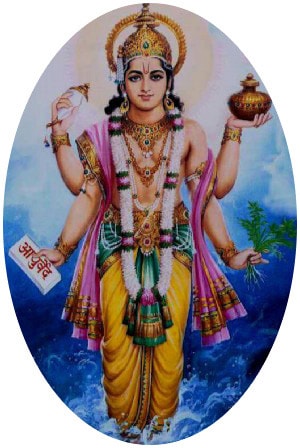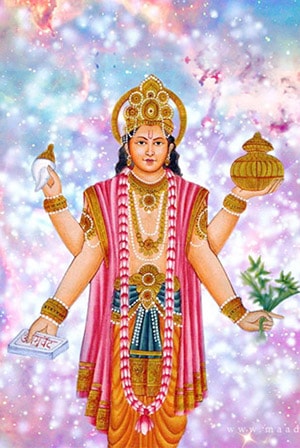
Dhanvantari is an avatar of Vishnu in Hinduism. He appears in the Vedas and Puranas as the physician of the gods (devas), and the god of Ayurveda. It is common practice in Hinduism for worshipers to pray to Dhanvantari seeking his blessings for sound health for themselves and/or others, especially on Dhanteras.
Dhanvantari is a handsome individual and should usually be depicted with four hands, with one of them carrying Amrita, the ambrosia of god. Dhanvantari is depicted as Vishnu with four hands, holding Shankha, Chakra, Jalauka (leech) and a pot containing rejuvenating nectar called amrita. He is often shown with a leech in his hand rather than the scriptures
Bhagavata Purana states that Dhanvantari emerged from the Ocean of Milk and appeared with the pot of amrita (nectar) during the story of the Samudra (or) Sagara Mathana whilst the ocean was being churned by the Devas and Asuras, using the Mandara mountain and the serpent Vasuki. The pot of Amrita was snatched by the Asuras, and after this event another avatar, Mohini, appears and takes the nectar back from the Asuras. It is also believed that Dhanvantari promulgated the practise of Ayurveda.
His birthday is celebrated by the practitioners of Ayurveda every year, on Dhanteras, two days before Diwali, the Hindu festival of lights.
Lord Dhanvantari destroys negativity and blesses his devotees with good health.
Om Dhanvantaraye Namah
Ayurveda is a spiritual science in itself. It is believed that Ayurveda, as a branch of the Vedas, is a stream of the knowledge passed down from generation to generation since eternity, much in the same way as Vedic literature and the Vedic scriptures were. As the story goes, the knowledge of Ayurveda was created by Brahma, the Creator, who gave it to Prajapati, who passed it to the Ashwini Kumari (the celestial Twin Physicians), who in turn passed it down to Indra, and so on.
According to the Charaka Samhita, the knowledge of Ayurveda is eternal and is revealed in each of the cycles of creation of the universe. When needed, Lord Vishnu himself incarnates as Lord Dhanvantari and reestablishes the tradition of Ayurveda in the world to help relieve some of humanity’s suffering.
Lord Dhanvantari is known as the father of Ayurveda, since he was the first divine incarnation to impart its wisdom amongst humans. He first appeared during the great churning of the cosmic ocean of milk (Samudra manthan) to deliver amrit (ambrosia, or Divine nectar) to the demigods. The churning of the ocean of milk is a famous episode in the Puranas that represents the spiritual endeavor of a person to achieve Self-realization through concentration of mind, withdrawal of the senses, control of all desires, austerities and asceticism. It is celebrated in India every twelve years in the holy festival known as Kumbha Mela.
The following story is related in the Srimad Bhagavatam.
Using the mountain Mandara as the rod and Vasuki the serpent as the cord, both demigods and demons proceeded to churn the ocean of milk. All kinds of herbs were cast into it. The churning was so arduous that Lord Vishnu had to appear in many forms to help them with this process and prevent it from going nowhere. He even appeared as Lord Vishnu himself sitting on top of the mountain to infuse Indra and his companions with energy.
The churning of the ocean of milk first produced a deadly poison (halahala) that only Lord Shiva could swallow without being affected by it. And so he did, except that his consort Parvati pressed his neck as he was swallowing, so that the poison would not reach his stomach, and the halahala stayed in Lord Shiva’s throat, changing the color of his neck to blue due to its potency. This is why Lord Shiva is also called Neelakantha, or the blue-necked one.
During the churning, many Divine objects and beings emerged from the ocean, including Kamadhenu (the wish fulfilling cow), Ucchaisrava (the white horse), Airavata (the white elephant), Kaustubhamani (a rare diamond), Kalpavriksha (the wish fulfilling tree), and Shri Laxmi, the Goddess of Wealth, who after being worshipped by all Gods, demigods, asuras and everyone else present, was reunited with her husband Lord Vishnu after having been separated for many ages.
As the churning continued, Lord Dhanvantari appeared. He was young and strongly built, his chest was very broad and his complexion bluish black. He had strong arms, reddish eyes, and moved like a lion. He was clad in bright yellow, his curly hair was anointed with oil and he wore shining earrings made of pearl. As he emerged, he was holding a conch, leeches, healing herbs, a chakra (one of the divine weapons of Lord Vishnu’s), and the long sought pot of ambrosia, for which he is also called Sudha Pani (“carrying nectar”). The asuras, greedy after all things, realized right away that the container was full of nectar and snatched it from him.
Again filled with greed and pride, the demons started quarreling about which of them would drink the nectar first, grabbing the pot from one another and behaving like thieves. Seeing how busy they were fighting with each other, Lord Vishnu didn’t miss the opportunity to trick them. He appeared as Mohini, a beautiful woman who fascinated the demons, recovered the nectar from them, and distributed it only amongst the demigods. As soon as the demigods drank it, they were invigorated with energy and defeated the demons. After worshipping Lord Vishnu and Shri Laxmi, they resumed their position in the heavens.
At the time of the churning, Lord Vishnu foretold that Lord Dhanvantari would appear again in the world to teach men the science of Ayurveda. And so he did, after Lord Indra, seeing humanity so afflicted by pain and disease, pleaded with Lord Dhanvantari to descend into the material world and teach Ayurveda to the human race.
King Dirghatamas of Kashi (Benares) was performing severe austerities and offering them to Lord Dhanvantari in the hopes that he would be pleased with them and grant him a son. The Lord appeared and offered a boon to the king, so Dirghatamas asked Lord Dhanvantari to be born as his own son. The Lord replied that he would.

Soon after, Lord Dhanvantari was born in the royal household of Kashi and eventually became the king. Even as a young boy he had ascetic tendencies, was extremely disciplined and performed severe austerities. He taught Ayurveda orally to the sages and rishis (seers) who became his disciples. His teachings are recorded in the Agni Purana, as well as through the teachings of his disciples Susruta, Pauskalavata, Aurabha, Vaitarana, and others.
May this story remind the reader that although used for thousands of years, Ayurvedic principles have never changed, since they derive from universal laws of nature that are eternally true, and that they should be preserved and transmitted along with the strong spiritual tradition they originally emerged from.
It is written in the scriptures that, “One who remembers the name of Dhanvantari can be released from all disease.” Lord Dhanvantari is worshipped all over India as the God of Medicine. Even today, two days before Diwali, the Festival of Lights, people remember and honor him. At dusk, a lamp pointing toward North by North-East is lit at the doorstep of the house to welcome Lord Dhanvantari for health and happiness in life. This day is known as Dhanteras (or Dhanwantari Triodasi, or Dhantrayodashi).
It is worth mentioning that outstanding authorities on Ayurveda were also honored in ancient and medieval India with the name “Dhanvantari.” So the name now refers not only to the divine preserver of Ayurveda, but is also associated with the hierarchy and rich medical tradition in the history of India. The original Dhanvantari, one of the many avatars (divine incarnations) of Lord Vishnu’s, is known as Adi-Dhanvantari.

